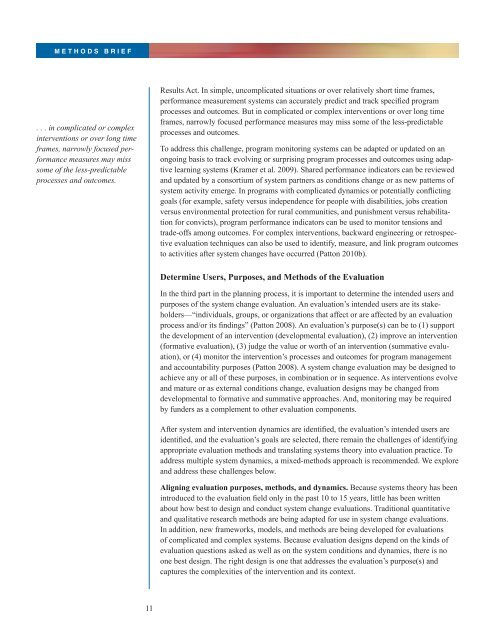Evaluating System Change - Mathematica Policy Research
Evaluating System Change - Mathematica Policy Research
Evaluating System Change - Mathematica Policy Research
You also want an ePaper? Increase the reach of your titles
YUMPU automatically turns print PDFs into web optimized ePapers that Google loves.
M E T H O D S B R I E F<br />
. . . in complicated or complex<br />
interventions or over long time<br />
frames, narrowly focused performance<br />
measures may miss<br />
some of the less-predictable<br />
processes and outcomes.<br />
11<br />
Results Act. In simple, uncomplicated situations or over relatively short time frames,<br />
performance measurement systems can accurately predict and track specified program<br />
processes and outcomes. But in complicated or complex interventions or over long time<br />
frames, narrowly focused performance measures may miss some of the less-predictable<br />
processes and outcomes.<br />
To address this challenge, program monitoring systems can be adapted or updated on an<br />
ongoing basis to track evolving or surprising program processes and outcomes using adaptive<br />
learning systems (Kramer et al. 2009). Shared performance indicators can be reviewed<br />
and updated by a consortium of system partners as conditions change or as new patterns of<br />
system activity emerge. In programs with complicated dynamics or potentially conflicting<br />
goals (for example, safety versus independence for people with disabilities, jobs creation<br />
versus environmental protection for rural communities, and punishment versus rehabilitation<br />
for convicts), program performance indicators can be used to monitor tensions and<br />
trade-offs among outcomes. For complex interventions, backward engineering or retrospective<br />
evaluation techniques can also be used to identify, measure, and link program outcomes<br />
to activities after system changes have occurred (Patton 2010b).<br />
Determine Users, Purposes, and Methods of the Evaluation<br />
In the third part in the planning process, it is important to determine the intended users and<br />
purposes of the system change evaluation. An evaluation’s intended users are its stakeholders—“individuals,<br />
groups, or organizations that affect or are affected by an evaluation<br />
process and/or its findings” (Patton 2008). An evaluation’s purpose(s) can be to (1) support<br />
the development of an intervention (developmental evaluation), (2) improve an intervention<br />
(formative evaluation), (3) judge the value or worth of an intervention (summative evaluation),<br />
or (4) monitor the intervention’s processes and outcomes for program management<br />
and accountability purposes (Patton 2008). A system change evaluation may be designed to<br />
achieve any or all of these purposes, in combination or in sequence. As interventions evolve<br />
and mature or as external conditions change, evaluation designs may be changed from<br />
developmental to formative and summative approaches. And, monitoring may be required<br />
by funders as a complement to other evaluation components.<br />
After system and intervention dynamics are identified, the evaluation’s intended users are<br />
identified, and the evaluation’s goals are selected, there remain the challenges of identifying<br />
appropriate evaluation methods and translating systems theory into evaluation practice. To<br />
address multiple system dynamics, a mixed-methods approach is recommended. We explore<br />
and address these challenges below.<br />
Aligning evaluation purposes, methods, and dynamics. Because systems theory has been<br />
introduced to the evaluation field only in the past 10 to 15 years, little has been written<br />
about how best to design and conduct system change evaluations. Traditional quantitative<br />
and qualitative research methods are being adapted for use in system change evaluations.<br />
In addition, new frameworks, models, and methods are being developed for evaluations<br />
of complicated and complex systems. Because evaluation designs depend on the kinds of<br />
evaluation questions asked as well as on the system conditions and dynamics, there is no<br />
one best design. The right design is one that addresses the evaluation’s purpose(s) and<br />
captures the complexities of the intervention and its context.
















